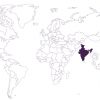The industry and government must adapt to meet the ever-evolving healthcare needs of India’s citizens
With the rise in awareness, affordability and lifestyle diseases, healthcare continues to be one of the key needs of the country. Additionally, due to the advent of innovative technology solutions for India’s healthcare requirements and the government’s increased focus on the sector, India’s healthcare sector is at a critical juncture.
The next few years have the potential to define how well India will be able to tackle its long-standing healthcare issues, and at the same time, adapt to meet the ever-evolving healthcare needs of its citizens.
PATIENT AS A CONSUMER
With the increase in access to information, aided by mobile penetration and ever-increasing data speeds, the power equation between patients and doctors is changing. The millennial generation no longer takes the doctor’s word as gospel truth and instead, looks for validation through second opinion and accessing information available online. Moreover, the advent of social media platforms has led to emergence of new methods of patient engagement. Recognising this shift in patient behaviour, providers have also started adopting newer methods of patient engagement to attract and retain customers.
However, this rise in consumerism, unlike other sectors, is a double-edged sword in the case of healthcare. While it keeps the medical fraternity on its toes and makes them more accountable, it has also created a trust deficit that can lead to misguided consumer activism. Healthcare is a complex and subjective field, where several variables affect the outcomes. However, patients have increasingly started to feel entitled to outcomes, and feel aggrieved and wronged in case they are unfavourable. This tenuous relationship between patients and doctors is further being put under stress due to reports of overcharging or negligence in a few specific cases. There is a need to bring back the sanctity of this relationship.
THE AFFORDABILITY CONUNDRUM
Given the large number of people still living below the poverty line in India, the affordability of quality healthcare is a problem and needs to be addressed by looking at both sides of the equation, cost of delivery on the one hand, and people’s ability to pay for it on the other.
COST OF DELIVERY
Of late, there appears to be an increasing focus on tackling the affordability issue by regulatory actions that control prices. However, the issue of cost containment needs to bear in mind the following
In today’s age of innovation and advancement, there is a wide variety and quality of equipment, devices and drugs that is available globally. If India is to continue to attract the top-end products and technologies, the prices have to ensure economic viability for such premium products. With continuously reducing prices, there is a risk of such products and services disappearing from the Indian market.
There is a threshold below which the quality vs cost equation can become dangerously tilted in favour of low quality, especially in the case of healthcare products and services. Therefore, it is critical that the government draw a balance between these and find measures to mitigate the risk of lowering prices leading to corresponding reduction in quality to sustain the margins. An increased focus on, and a well-implemented plan for quality control is critical at this juncture.
Healthcare, in today’s age is provided in large measure by the private sector and is funded by corporates or private equity investors who will expect a fair return on investment.
Moreover, there is a need to review the notion that the healthcare players are making super-normal profits. While evaluating costs and margins, healthcare delivery needs to be assessed as a continuum and not broken up into various components and products. There is a need to co-opt experts, who will carry out a fair and accurate assessment of the true cost of a delivery.
This would take into account requirements of minimum quality as well as an understanding that, beyond a point, increase in volumes cannot lead to lower costs in the case of healthcare. There are constraints on capacity of both equipment as well as medical professionals. Moreover, considering that India depends heavily on private healthcare infrastructure, any steps that make investing in it nonviable will exacerbate the already existing shortage of health infrastructure.
ABILITY TO PAY
In a poor country such as India, and for a high investment sector like healthcare, it will never be possible to solve the affordability issue by simply attacking the cost side. There is a need to address the other side of the equation too, i.e. ability to pay.
The government should focus on healthcare financing, particularly for the part of population that cannot afford healthcare. Launching the National Health Protection Scheme (NHPS) is a step in the right direction. However, the success of the scheme will depend on how well it is detailed out, and implemented on the ground.
In order to generate maximum value out of the massive investment by the government in this scheme, efforts should be made to encourage and incentivise wellness/preventive care and making primary care (including basic diagnostic tests and outpatient care) accessible and affordable for all. This will not only improve the overall health of the population, but also free up resources and reduce the overall cost to the exchequer.
Technology can play a significant role in managing population health. Big data analytics and artificial intelligence (AI) can help us in the areas of risk identification, disease prevention and early diagnosis, and the government must use these for public health purposes. Lastly, it is critical that issues of quality and sustainability be borne in mind while setting package prices under NHPS in a manner that balances quality and economic viability.
To conclude, healthcare is a very complex sector and several countries and societies are struggling to get it right.
We, in India, are fortunate to have an extremely competent pool of healthcare resources, who can boast of some of the best health outcomes. India is called the ‘pharmacy of the world’ and is fast becoming the hub for innovation and manufacturing. All we need is for the private sector and the government to work collaboratively and with trust and respect for each other. Each can support the other and work towards creating a healthcare sector that ensures quality healthcare to the poorest of the poor, as well as facilitates the availability of best-in-class products and services to those who can afford it.










